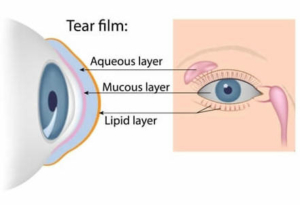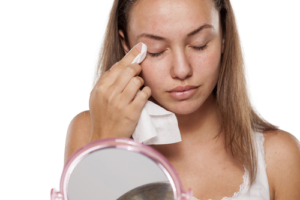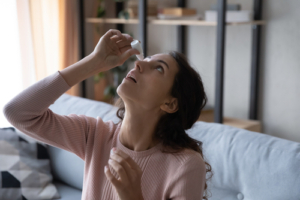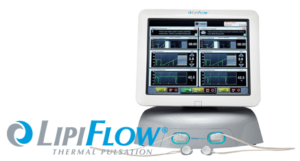What Does the Tear Film Do?
Tears are essential to your eye and vision health. With every blink, tears spread over the front of your eye.
A vital part of this is the tear film. Your tear film needs the proper nutrients and components to have healthy tears.
The tear film ensures your vision is clear and your eyes are comfortable. If you’re not blinking enough, dry spots can form on the surface of your eye and cause discomfort, among other symptoms.
Keep reading to learn more about the essential functions of your tear film and what happens if you don’t have quality or sufficient tears.
The Function of the Tear Film

The glands in your eyelids normally produce tears that contain three layers. These layers make up the tear film.
Together, the layers prevent eye infections and maintain the health of your eyes. They include:
Mucus Layer
The innermost layer of your tear film is called the mucus layer. It’s secreted by the conjunctival cells. The mucus layer of the tear film ensures your tears receive even distribution and stabilizes the tear film.
Watery Layer
The middle part of your tear film consists of the watery layer made by the lacrimal glands. Your tears mainly comprise the liquid layer.
Its job is to flush out any foreign particles in your eyes and keep them moist.
Oily Layer
The oily layer of the tear film is in the outer section. It ensures the tear surface remains smooth and doesn’t evaporate too quickly.
The meibomian glands produce this layer in your eyes. When any part of your tear film isn’t functioning correctly, it may lead to creating poor-quality tears or not making enough tears. As a result, you may start experiencing symptoms of dry eyes.
Dry Eyes

Dry eyes can cause significant discomfort and irritation. Some of the symptoms of dry eyes include:
- Eye redness
- Sensitivity to light
- Eye fatigue
- Burning sensation in the eyes
- Difficulty wearing contacts
- Stringy mucus around and in your eyes
- Blurred vision
- A feeling of having something in your eyes
Dry eye is a progressive and chronic condition, meaning it affects you daily and continues to worsen if you don’t receive proper treatment for it. Besides being frustrating and uncomfortable, dry eye can cause conjunctivitis when left untreated. It can also increase your risk of eye infections, damage your cornea, and even lead to vision loss in severe cases.
Dry Eye Treatment
Depending on its severity and the underlying cause, it may take a combination of different treatments to manage and control dry eyes. Most patients can control their dry eye symptoms and improve their quality of life.
Below are some treatments that your eye doctor at Eye Consultants of North Dakota may recommend to reduce the symptoms and manage your dry eyes.
Medications
You can use oral medications or eye drops to increase natural tear production and alleviate dry eye symptoms.
Eyelid Cleansers

Your dry eyes may be due to debris on your eyelids. Cleansers like Cliradex and Ocusoft help remove pollen, debris, oil, mites, and other contaminants from your eyelids and eyelashes that may be causing dry eyes and any irritation.
Serum Tears
Serum tears are eye drops made from your blood. The clear component of your blood is separated to create them.
These tears have the same biological nutrients found in your natural tears and provide relief for dry eyes.
Over-the-Counter

If you have a mild case of dry eyes, you can use over-the-counter eye drops to find relief. Using eye drops and artificial tears at the first sign of dryness or irritation can make a big difference.
Surgical Procedures
When other treatment options are not working, a punctal occlusion procedure can help alleviate dry eyes. The procedure involves inserting tiny, biocompatible punctal plugs into the tear drainage canals of the eyes to block drainage.
Doing so keeps tears in your eyes instead of allowing them to evaporate from the eyes before delivering crucial nutrients. Moisture in your eyes increases comfort and minimizes dry eye symptoms.
Amniotic Membrane
The amniotic membrane is a safe and effective solution for chronic dry eyes due to corneal surface damage. Amniotic membranes graft a delicate piece of tissue from another part of your body.
Your ophthalmologist at Eye Consultants of North Dakota places it over your cornea with a tiny ring for a few days. The tissue encourages corneal healing and keeps moderate to severe dry eyes comfortable for several months.
Specialty Contact Lenses

Scleral lenses are specialty contact lenses used for dry eye patients. These rigid gas permeable lenses (RGP) have a bowl-like design.
They leave a space between them and the surface of your cornea. The bowl is filled with a saline solution before it’s inserted into your eye.
This solution allows your eyes to remain moist and comfortable throughout the day, offering much-needed relief from dry eyes.
LipiFlow

Many people experience severe dry eye symptoms because of meibomian gland dysfunction (MGD). MGD is a chronic inflammatory condition.
Meibomian glands are found in your lower and upper lids and release the oil layer of the tear film that prevents it from evaporating. If these glands become blocked due to meibomian gland dysfunction, it leads to chronically dry eyes.
LipiFlow is a highly effective procedure and one of the most advanced ways to treat MGD. The treatment involves gently applying controlled pressure to the outer eyelid and heat to the inner eyelid surfaces simultaneously.
This action removes blockages and restores oil flow from the meibomian glands.
Don’t Live with Dry Eyes when Help is Available

Dry eyes can be debilitating and make everyday tasks a constant struggle. But you don’t have to live with dry eyes.
The top-rated eye doctors at Eye Consultants of North Dakota can accurately diagnose your condition and provide a highly individualized treatment plan to relieve your symptoms.
Are you suffering from the effects of dry eyes? Schedule your appointment at Eye Consultants of North Dakota in Fargo, ND, to get the relief you need!



